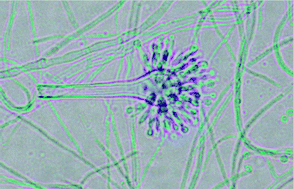 Fungal antigens, e.g. from damp homes, have been linked to a variety of illnesses and allergies. Traditional techniques of identifying them, such as culture based-methods or microscopy, have several drawbacks including not being able to identify fungal fragments and limitations in species classification. Currently available commercial monoclonal antibody-based ELISAs are avilable, however they have not been as successful in fungal identification as they have been in other common indoor allergens.
Fungal antigens, e.g. from damp homes, have been linked to a variety of illnesses and allergies. Traditional techniques of identifying them, such as culture based-methods or microscopy, have several drawbacks including not being able to identify fungal fragments and limitations in species classification. Currently available commercial monoclonal antibody-based ELISAs are avilable, however they have not been as successful in fungal identification as they have been in other common indoor allergens.
This paper describes the development and validation of an enzyme sandwich ELISA designed to quantify A. versicolor antigens using polyclonal antibodies. Samples from infected homes were collected and tested using the newly developed assay and the results were compared to the commercially available ELISA, colony forming units and fungi cultivations.
Proteins from A. versicolor spores and myecelia were extracted and subcutaneously injected into a rabbit. The antibodies produced were then isolated and coated on to the plates to produce the immunoassays. Positive and negative controls were run as well as the environmental samples.
In brief the assay proved to be very sensitive (range = 0.12–4.5 ng mL-1) and precise with intra-assay coefficient of variation (CV) = 4% and inter-assay CV = 11%. Cross reactivity with other moulds was observed, although at intensities significantly lower than A. versicolor. The assay also appeared to be more successful in environmental analysis than the commercial assay, showing a positive result for 88% of dust and 89% of bulk samples, with the commercial AveX ELISA only indicating positive results for 27% and 24% respectively. This may be partly attributed to all the A. versicolor samples cultured showing A. versicolor antigens, whereas only 12 contained identifiable AveX antigens. A wide range of proteins were shown to be identifiable by the polycolonal A. versicolor antibodies, although not smaller proteins (20–6 KDa) from the myecelia.
This immunoassay has been demonstrated to be effective in environmental studies and could prove to be a significant technique for those identifying and quantifying fungal infestations.
This HOT article would be of interest to anyone involved in fungal identification or the development of immunoassays. You can access it from the website for free for the next couple of weeks*!
Eva Zahradnik, Sabine Kespohl, Ingrid Sander, Ursula Schies, Janett Khosravie-Hohn, Wolfgang Lorenz, Steffen Engelhart, Annette Kolk, Gerd Schneider, Thomas Brüning and Monika Raulf-Heimsoth
*Free access to individuals is provided through an RSC Publishing personal account. Registration is quick, free and simple










